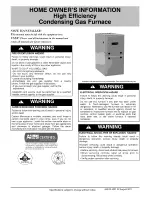
31
Gas Piping Checks
Before placing the furnace in operation, leak test the furnace and
gas connections.
Check for leaks using an approved chloride-free soap and water
solution, an electronic combustible gas detector, or other
approved testing methods.
NOTES:
■
Never exceed specified pressures for testing. Higher pressure
may damage the gas control valve and cause subsequent
overfiring, resulting in heat exchanger failure.
■
Disconnect this unit and external manual shutoff valve from
the gas supply piping system before pressure testing the
supply piping system with pressures in excess of
¹⁄₂
psig
(3.48 kPa).
■
Isolate this unit from the gas supply piping system by closing
the external manual shutoff valve before pressure testing
supply piping system with test pressures equal to or less than
¹⁄₂
psig (3.48 kPa).
Propane Gas Tanks and Piping
A gas detecting warning system is the only reliable way to detect
a propane gas leak. Rust can reduce the level of odorant in
propane gas. Do not rely on your sense of smell. Contact a local
propane gas supplier about installing a gas detecting warning
system.
All propane gas equipment must conform to the safety standards
of the National Board of Fire Underwriters, NBFU Manual 58.
For satisfactory operation, propane gas pressure must be 11"
W.C. at the furnace manifold with all gas appliances in operation.
Maintaining proper gas pressure depends on 3 main factors:
■
Vaporization rate, depending on temperature of the liquid and
“wetted surface” area of the container or containers.
■
Proper pressure regulation. Two-stage regulation is
recommended for both cost and efficiency.
■
Pressure drop in the lines between the regulators, and
between 2
nd
stage regulator and the appliance. Pipe size will
depend on the length of the pipe run and the total load of all
appliances.
Complete information regarding tank sizing for vaporization,
recommended regulator settings, and pipe sizing is available
from most regulator manufacturers and propane gas suppliers.
Since propane gas will quickly dissolve white lead and most
standard commercial compounds, special pipe dope must be
used. Shellac-based compounds resistant to the actions of
liquefied petroleum gases, such as Gasolac
®
, Stalactic
®
, Clyde’s
®
or John Crane
®
are satisfactory.
Refer to “Propane Gas Installation—Typical” for typical propane
gas installations and piping.
Propane Gas Installation—Typical
Sizing Between 1
st
and 2
nd
Stage Regulator*
Maximum propane capacities listed are based on 2 psig pressure drop at 10 psig setting. Capacities in 1,000 Btu/h.
Goodman 63
To avoid the possibility of explosion or fire, never use a
match or open flame to test for leaks.
WARNING
Goodman 64
If the gas furnace is installed in a basement, and
excavated area or a confined space, it is strongly
recommended to contact a propane supplier to install a
gas detecting warning device in case of a gas leak.
—
Since propane gas is heavier than air, any leaking can
settle in low areas or confined spaces.
—
Propane gas odorant may fade, making the gas
undetectable except with a warning device.
WARNING
A. 1
st
stage regulator
B. 5 to 15 psig (20 psig maximum)
C. 200 psig maximum
D. 2
nd
stage regulator
E. Continuous 11" W.C.
A
D
C
B
E
Propane Gas Piping Chart I
Tubing Size, O.D. Type L
Nominal Pipe Size Schedule 40
Pipe or Tubing Length—ft (m)
³⁄₈
"
¹⁄₂
"
⁵⁄₈
"
³⁄₄
"
⁷⁄₈
"
¹⁄₂
"
³⁄₄
"
10 (3)
730
1,700
3,200
5,300
8,300
3,200
7,500
20 (6.1)
500
1,100
2,200
3,700
5,800
2,200
4,200
30 (9.2)
400
920
2,000
2,900
4,700
1,800
4,000
40 (12.2)
370
850
1,700
2,700
4,100
1,600
3,700
50 (15.2)
330
770
1,500
2,400
3,700
1,500
3,400
60 (18.3)
300
700
1,300
2,200
3,300
1,300
3,100
80 (24.4)
260
610
1,200
1,900
2,900
1,200
2,600
100 (30.5)
220
540
1,000
1,700
2,600
1,000
2,300
125 (38.1)
200
490
900
1,400
2,300
900
2,100
















































